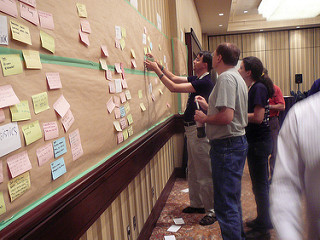Top 7 Features to Look for in a Contract Management Solution
Congratulations! After your hard work evangelizing about the benefits of CLM software across your enterprise for several months, you’ve finally proven your case to the appropriate decision makers and given the green light in implementing the software in your enterprise. Now it’s the moment to truly demonstrate the ability of contract software to reduce the error rate across contracts and provide a company-wide data repository in real time. To help you choose the right CLM software, here is a checklist of key seven features to look for.
- Centralize Request and In-Take of Contract Data
Through their processes, contract managers receive a massive amount of data. Ranging from emails to Microsoft Word documents to PDF files, clients and co-workers provide key data that needs to be somehow captured. To prevent “data leakage” CLM software should have a request module to centralize requests and in-take of contract data. Centralized in-take of contract data allows contract managers to generate contract documents faster by automatically dropping the information into approved templates.
Look for a request module that enables you to create customizable forms to capture any contract data. Ask whether or not the forms will be visible by administrators and recipients on any device. This is a key detail so that both parties can use the forms using any device, in the office or on the road, at any time. Also, verify that the forms can handle encrypted upload of documents.
- OCR Technology
Still, you may end up receiving paper documents via regular mail or as PDF attachments via email. In a paper-based or uncoordinated digital contract management system, such documents and PDF attachments don’t provide automatic notices about deviations from pre-approved contract language or changes in clauses.
To overcome this challenge, look for a CLM solution that leverages OCR technology to make those documents searchable by text and verifiable against templates and clauses within your library of contracts. A best-in-class CLM software must be able to automatically compare and track language changes throughout negotiations. As experts from the IACCM declare, “If we can’t track changes we are ‘blind'”.
- Seamless Integration
According to the “Best-in-Class Performance in Contract Management” report from the Aberdeen Group, Best-in-Class companies have more than 75% of their contracts in a searchable repository, compared to all others who only have about 33%. Your CLM solution should be able to send, receive, and sync data from multiple data sources and format, even spreadsheet data. Through seamless integration of all your contract data with CRM, ERP, Finance, and any other types of systems, contract managers can truly make informed decisions.
Also, inquire whether or not the integration process can be customized to the needs and rules of your industry.
- Customizable Workflow Module
Making sure that you’re capturing all contract data and making it all searchable is great, but making that contract data actionable in a timely manner is better. Look for a CLM software that lets you customize the processes of your contract lifecycle according to the unique needs and rules of your enterprise and industry. For example, you could automate document and record routing within the compliance rules of your industry.
Also, seek a CLM solution that automatically alerts internal and external users about a step or process. Three very desirable features of a workflow module are the ability to set rules of escalation for processes, maintain parallel and simultaneous workflow processes and steps, and trigger workflows automatically based on set criteria. This way your contract data becomes truly actionable and processes are completed more timely.
- Customizable Dashboard
On top of automated alerts, triggers of workflows and steps, and parallel processes, a customizable dashboard is a key feature because it allows you to streamline contract management processes. Some of the reasons why dashboards make contract management easier include prevention of information asymmetry, improvement of client management, and facilitation of better project management.
- Native Microsoft Word Integration
Without a doubt, MS Word is a key tool used by contract managers to create documents. Therefore, look for native MS Word integration that allows your contract mangers work with the same tool they use every day – without ever having to leave the CLM software. Not only does this accelerate the learning curve for users, but also allows users to leverage skills they have acquired over time.
- Electronic Signature
Without a doubt, digital signatures are an important of a comprehensive contract management solution. Look for a vendor that has partnered with several leading businesses within the field of electronic signatures. For example, Contract Logix counts DocuSign, Echosign, and Sertifi as their technology and integration partners for electronic signature. By choosing CLM software that uses today’s most popular and reliable e-signature system, you’re choosing the most reliable to sign and execute contracts.


